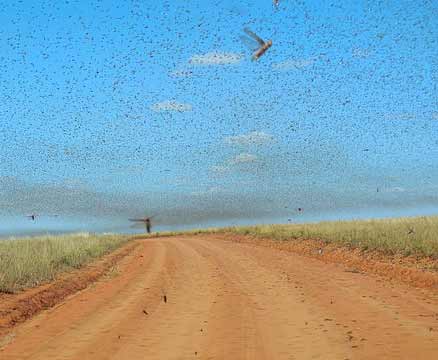Locust swarms threaten to destroy crops in Northern India

The swarm of locust has reached Jaipur in Rajasthan after destroying crops in the border areas of Pakistan. On Monday morning, a large group of locusts were seen in Badi Chaupar and surrounding areas like Murlipura, Jawahar Nagar Vidyadhar Nagar and many other areas in the Parkota area of Jaipur. Seeing the attack of this swarm, people started saving trees and plants in their homes.
The locust swarm has entered in Jaipur district after nearly 27 years. Earlier in 1993, locusts had snapped crops in Jaipur district. After the damage in Rajasthan, the swarm moved towards the border of Madhya Pradesh. They are likely to reach several cities including Agra in Uttar Pradesh. The administration has alerted about this.
Early entry this year
As per officials, locust swarms from Pakistan have entered Rajasthan, Punjab, Haryana and Madhya Pradesh. This is expected to cause heavy losses to cotton crops and vegetables. Rajasthan is the most affected state. This year a locust team arrived early. It usually falls in June-July.
Due to wind, locus swarm travels further
Officials say that this time the locust teams have come so far due to the wind aiding them. Control is being tried on them. State Chief Minister Ashok Gehlot says that officials have been asked to take action to control the pests. At the same time a letter has been written to Prime Minister Narendra Modi.
Why are they harmful for agriculture
A species of grasshopper desert locust is commonly found in deserted areas. It grows from an egg into a winged locust, but sometimes the desert locust takes a dangerous form. When many desert locusts gather on lush green grasslands, they do not behave like normal insect-mites living in uninhabited places, but together they form a giant swarm.
There can be ten billion grasshoppers in these swarms flying in the sky. These can be spread over an area of hundreds of kilometers. These herds can travel 200 kilometers in a day. These swarms of locusts in one day can damage crops grown in such a large area for their food and breeding purposes. According to the Food and Agriculture Organization of the United Nations, an average grasshopper party can siphon a grain which is enough to feed two and a half thousand people.
Could travel from East Africa to India, Pakistan next month: UN officials
A top official of the Food and Agriculture Agency of the United Nations warned that a contingent of desert locusts posing a threat to livelihood and food security could move from East Africa to India and Pakistan next month, along with herds of other insects. The desert locust is considered to be the most destructive migratory insect in the world and a swarm spread over a square kilometer can contain up to eight crore locusts.








